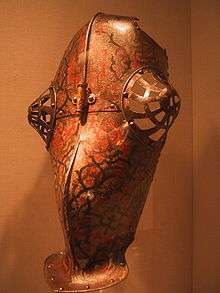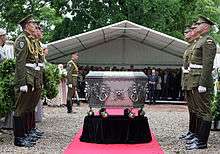Mikołaj "the Black" Radziwiłł
| Mikołaj "the Black" Radziwiłł | |
|---|---|
|
Portrait of Mikołaj 'Czarny' Radziwiłł | |
| Born |
February 4, 1515 Nesvizh (now in Belarus)[1] |
| Died |
May 28, 1565 (aged 50) Vilnius |
| Resting place | Dubingiai, Lithuania |
| Religion | Calvinism |
| Spouse(s) | Elżbieta Szydłowiecka |
| Children |
with Elżbieta Szydłowiecka: Mikolaj Krzysztof Radziwiłł Elżbieta Radziwiłł Zofia Agnieszka Radziwiłł Anna Magdalena Radziwiłł Jerzy Radziwiłł Albrycht Radziwiłł Stanisław Pius Radziwiłł Krystyna Radziwiłł |
| Parent(s) |
Jan Radziwiłł Anna Kiszka |
Mikołaj Krzysztof Radziwiłł (1515 - 1565), nicknamed The Black, was a Polish-Lithuanian noble[2] who held several administrative positions within the Grand Duchy of Lithuania: Voivode of Vilnius, Grand Lithuanian Chancellor, and Grand Hetman of Lithuania.
Alternate renditions of his name include Lithuanian: Mikalojus Radvila Juodasis, Belarusian: Мікалай Радзівіл Чорны, and Latin: Nicolaus Radvil. His first name is sometimes given in English as Nicholas.[1][3]
Mikołaj was able to gain much political influence thanks to the romance between his cousin Barbara Radziwiłł and King of Poland and Grand Duke of Lithuania Zygmunt II August.[4] This made him one of the most powerful royal advisers.[4] Mikolaj became Marshal of Lithuania, Grand Chancellor of Lithuania, as well as Palatine of Vilnius, gained immense wealth and became the most powerful magnate in the Commonwealth of that time.[4]
The growing influence of the Radziwiłł family was further bolstered when, during a diplomatic mission to Charles V and Ferdinand I, he and his cousin Mikołaj the Red received a hereditary title of Prince (Reichsfürst (SRI)).[4]
He formed an alliance with his cousin Mikołaj "the Red" Radziwiłł against other notable Lithuanian families in the rivalry for the dominant status in the Great Duchy of Lithuania.[4] This alliance marked the formation of a dynastic-like cooperation between Radziwiłłs and showed how family interests could affect magnates' relations with the state.[4] Both Radziwiłłs backed the cause of Lithuania's sovereignty and opposed the growing Polish-Lithuanian union.[4]
Coincidentally, despite opposing close ties with Poland, he was the chief negotiator in the successful negotiation between Grand Duchy of Lithuania and the state controlled by the Livonian Order, which led to the secularisation of Livonia and its union with Grand Duchy of Lithuania in 1562.[4]
Mikołaj contributed to the ongoing Polonisation of the Grand Duchy, influencing other Lithuanian nobles to follow him in adopting Polish culture – its fashion, customs and language.[4]

He was known for his religious beliefs, as he was one of the most prominent converts and advocates of the Reformed churches faith in Grand Duchy of Lithuania.[4] He provided financial support for the printing of the first complete Polish translation of the Bible in 1563 in Brest-Litovsk, distributed works written in defense of the Reformed faith, financed a church and college in Vilnius, supported educated Protestants, and in various other ways fostered the Calvinist faith.[4] He is known to have exchanged letters with John Calvin and protected religious exiles from Italy. Because Protestants supported usage of local languages, he is also believed to have funded Lithuanian churches and schools.
With the exception of his daughter Anna, all his children converted to Roman Catholicism and became ardent supporters of the Counter Reformation. He is remembered by a statue in the Brest Millennium Monument.
Notes
- 1 2 Saulius A. Suziedelis (7 February 2011). Historical Dictionary of Lithuania. Scarecrow Press. p. 245. ISBN 978-0-8108-7536-4.
- ↑ M. L. Bush.Rich noble, poor noble.1988, p.46
- ↑ Oskar Halecki; W: F. Reddaway; J. H. Penson. The Cambridge History of Poland. CUP Archive. p. 405. ISBN 978-1-00-128802-4.
- 1 2 3 4 5 6 7 8 9 10 11 Peter Paul Bajer Short history of the Radziwill Family
